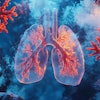WASHINGTON, DC -- Reports at this week's ARRS meeting and a recent journal say it again: For both MRI and CT, ultrafast approaches make a significant difference in enabling imaging of young children without conscious sedation.
First, a multidisciplinary team from the Walter Reed Army Medical Center in Bethesda, MD, used an ultrafast CT scanner to eliminate the need for children to be sedated.
Sedatives can cause problems, such as mild respiratory depression, in 5% of pediatric patients. Ultrafast CT uses a powerful magnet to steer an electron beam around the detector array. An entire chest CT can be done in 400 milliseconds with this equipment.
In this study, 16 patients, ranging in age from 3 weeks to 6 years old, were scanned without sedation. Evaluations performed included seven non-contrast studies of the head, one study of the neck, pre- and post contrast, six contrast-enhanced chest scans, and two enhanced scans of the abdomen and pelvis.
No adverse events, defined as physical injury, contrast reaction, or cardio-respiratory collapse, occurred in patient population, the group reported. None of the studies had to be repeated and the images were judged by three radiologists to be adequate diagnostic quality.
The investigators from the departments of radiology, pediatrics, and nursing will present their findings on May 8 at the American Roetgen Ray Society meeting in Washington D.C. (Scientific Session 9, Pediatrics: Extra-Abdominal, Paper 90, 1:54 p.m.).
The report reinforces a decade of studies recommending ultrafast CT for evaluation of young patients. A 1988 paper out of the University of California at San Francisco emphasized that ultrafast CT scan times of .05 or 0.1 seconds can eliminate motion artifacts even without patient sedation. In addition, rapidly moving structures such as the heart, airway and lungs can be visualized by acquiring serial .05-second CT images (Radiologic Clinics of North America, March 1988, Vol. 26:2, pp.277-286).
A second study compared ultrafast CT to conventional CT for imaging blunt abdominal trauma in children. The group from the Children's Hospital in Buffalo, NY, found no difference in diagnostic accuracy between an ultrafast protocol of 0.4-second images and 2-second conventional images (American Journal of Roentgenology, Oct. 1989, Vol. 153:4, pp.803-806).
Ultrafast technology also can make MR imaging of children less problematic. In a study published in the April issue of Magnetic Resonance Imaging, Austrian researchers evaluated ultrafast MRI of the brain and found it particularly suitable for patients who could not remain motionless for the average exam time of two to three minutes, including children in whom sedation was not possible.
In their study sample, the group from the University of Vienna imaged 33 patients, a dozen of whom could not remain still. Five of these 12 cases were children who were not sedated. Exams were performed using a 1.0-tesla superconducting system. Three types of images covering the entire neurocranium were obtained: axial T2 fast spin echo scan of two minutes and 57 seconds for 15 images, single shot T2 fast spin echo over 11 seconds for 20 images, and single shot T2 gradient spin echo over 17 seconds for 20 images.
The images were reviewed for lesions, image quality and artifacts. For the patient group with a tendency toward motion artifacts, including the non-sedated children, both ultrafast MRI images were superior to conventional MR, the authors reported. Lesions also were darker and more readily identifiable on the ultrafast pictures (MRI, April 2000, Vol. 18:3, pp.237-243).
"(Ultrafast MRI) provides diagnostically useful information in unsedated children, medically unstable patients and patients who cannot remain still, whose fast spin echo images are degraded by motion artifacts. The image artifacts in this subgroup of patients are the cause of a sequence-dependent difference in lesion detectability and are severe on conventional T2 fast spin echo in all cases," the authors concluded.
By Shalmali Pal
AuntMinnie.com staff writer
May 8, 2000
Let AuntMinnie.com know what you think about this story.
Copyright © 2000 AuntMinnie.com
















